Trees and other plants give off chemicals, called volatile organic compounds (VOCs.) The emission rate of these gases and molecules enables plants to communicate, contributes to cloud formation and affects air quality as well as the health of forests. VOCs are also responsible for what we associate as the fragrance of a forest. These emissions are very specific for each individual plant so each tree generates its own cloud.
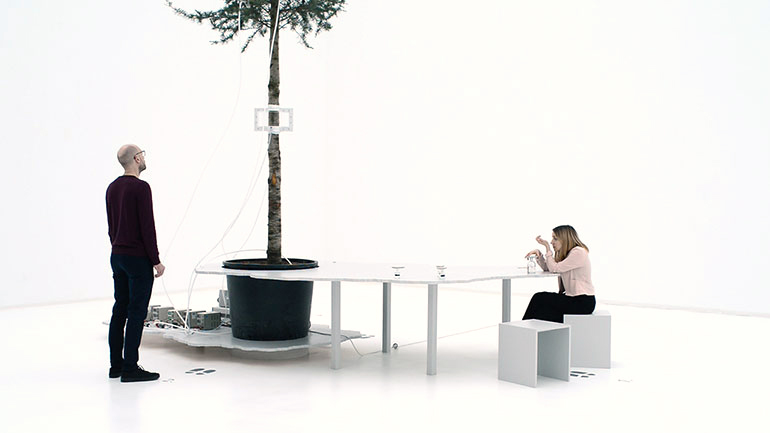
Agnes Meyer-Brandis, One Tree ID – How To Become A Tree For Another Tree, 2019 © Agnes Meyer-Brandis, VG-Bild Kunst 2019
One Tree ID, by Agnes Meyer-Brandis, transforms the ID of a specific tree into a perfume that can then be applied to the human body.
When wearing that perfume, a person can not only borrow some of the characteristics of the tree he/she is standing next to, but also use parts of its communication system and potentially have a conversation that —although imperceptible for the human communicator— might still take place on the biochemical level plants use for information exchange.
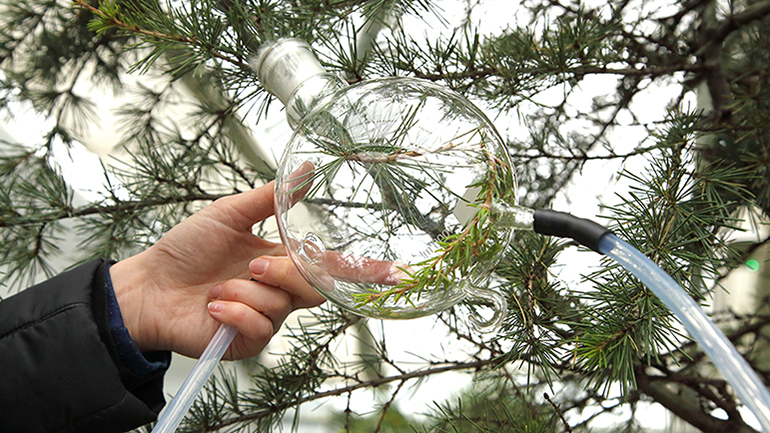
Agnes Meyer-Brandis, One Tree ID – How To Become A Tree For Another Tree (measurement of VOC emissions of the needles), 2019 © Agnes Meyer-Brandis, VG-Bild Kunst 2019

Agnes Meyer-Brandis, One Tree ID – How To Become A Tree For Another Tree, 2019 © Agnes Meyer-Brandis, VG-Bild Kunst 2019
Working together with bioscientists Prof. Dr. Birgit Piechulla and Dr. Uta Effmert from Rostock University, the artist chose a Himalayan Cedar for the first experiment and analyzed its molecule clouds and most of their components. Because the roots and its bacteria, the tree stem and needles emit different VOCs, the team measured the cloud of the roots, the cloud of the tree stem and the cloud of the needles separately. Over 100 different compounds were identified. Later on, the artist also invited perfumer Marc vom Ende to smell the tree. The data collected using science and a “professional” human nose were combined to create three perfumes: “Cloud of the Roots,” “Cloud of the Tree Stem,” and “Cloud of the Tree Crown.” Together they compose the unique One Tree ID perfume.
Agnes Meyer-Brandis, One Tree ID – How To Become A Tree For Another Tree, 2019
Towards the end of the interview, she also got to talk briefly about Office for Tree Migration, a response to a U.S. Forest Service study that found that some tree species are migrating North at a rate not seen before, likely due to global warming.
Hi Agnes! Is the cloud of a tree different from its smell? Or is smell just one part of the cloud?
Each tree and plant emit VOCs (Volatile Organic Compounds.) VOCs are very small and short lived molecules / gases. This is what we can smell when we go into a forest. These VOCs also contribute to aerosol formation thus also to cloud formation in general. But what we smell is just a part of this cloud, the cloud and VOC emission can contain also molecules which we cannot smell, at least not directly. They are also contained in the One Tree ID of course.
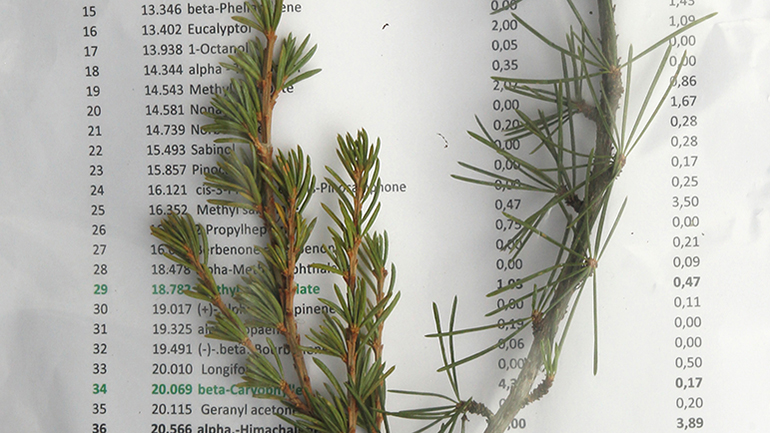
Agnes Meyer-Brandis, One Tree ID – How To Become A Tree For Another Tree, 2019 © Agnes Meyer-Brandis, VG-Bild Kunst 2019
I’m curious about the fact that 3 clouds were collected: one for the roots, one for the stem and one for the tree needles. Does that mean that a tree carries several clouds? How different are they from each other? this is so mysterious…
Yes, this is amazing to me as well. The needles, the tree stem, the roots and their bacteria, they all emit different VOCs and thus make different molecule clouds. We have measured the roots, the stem and the needles separately and could identify more than 100 compounds, some appeared only in the roots, some only in the tree stem or needles. From these data we synthesised the perfumes “Cloud of the Roots”, “Cloud of the Tree Stem” and “Cloud of the Tree Crone” and they smell really very different from each other. To my surprise, the roots smell quite sweet. The “One Tree ID” was fused from these 3 perfumes.
I would love to go even in more detail, so to say into higher resolution. I was wondering “Does each needle, each bacteria, each little branch make its own cloud?” For sure there is a difference between young and older needles, but to measure in that high resolution is also a question of capacities & resources. In sum, a tree is home to many lifeforms and clouds in all its parts.
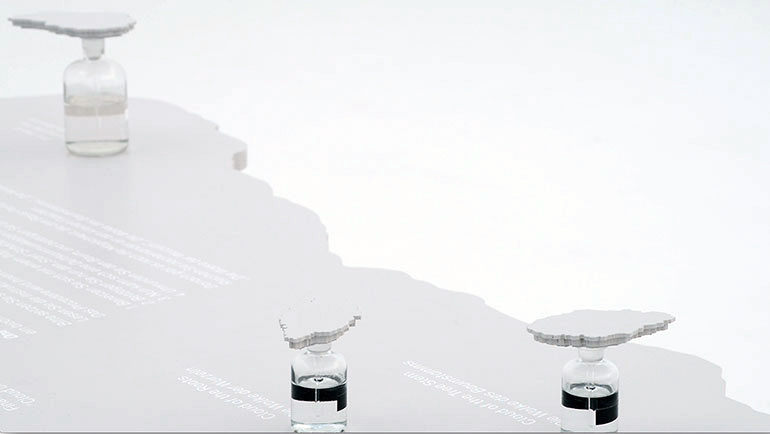
Agnes Meyer-Brandis, One Tree ID – How To Become A Tree For Another Tree, 2019 © Agnes Meyer-Brandis, VG-Bild Kunst 2019
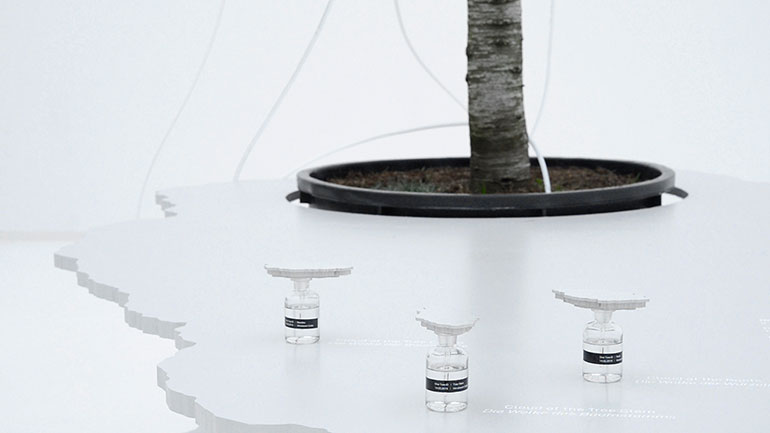
Agnes Meyer-Brandis, One Tree ID – How To Become A Tree For Another Tree, 2019 © Agnes Meyer-Brandis, VG-Bild Kunst 2019
Cedar trees smell very nice if i remember correctly. Does the VOC have that same smell?
Yes, exactly what we can smell of cedars are part of its VOC composition, these are small molecules which go into our nose and dock onto its receptors. The single VOC molecule can smell terrible but in combination it creates its specific good smelling cedar odour. I didn´t know how our data – transformed into a perfume would smell. The measured VOC compounds which were the basis for our perfume recipe could also have created some bad smell. I was especially curious about the roots. Luckily, they smell good.
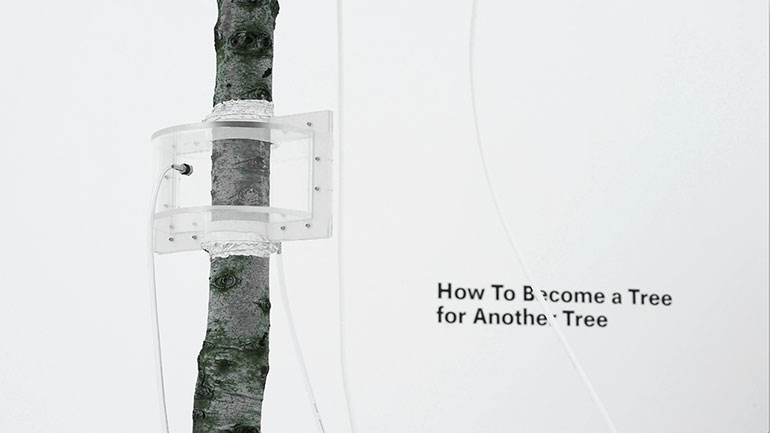
Agnes Meyer-Brandis, One Tree ID – How To Become A Tree For Another Tree, 2019 © Agnes Meyer-Brandis, VG-Bild Kunst 2019
And does the perfume you created affect human beings too? A bit like aromatherapy maybe?
We didn´t measure this, .. but I believe it does. A bit like what happens with forest bathing. In Japan, you can even buy tickets for this.
By wearing that perfume, a person can “potentially have a conversation that – although invisible and inaudible by nature – might still take place on the biochemical level plants use for information exchange.” But communication is a two way process! Would wearing the perfume trigger kind of reaction from the tree that might in theory be perceived (even unconsciously) by the human being?
Yes – it might be possible, the communication is something I really would love to explore further, but it is still very hard and expensive and until now not even possible to measure. However, I am in contact with some scientists, searching for a method to do so. It would be wonderful to create an instant translation and communication system.
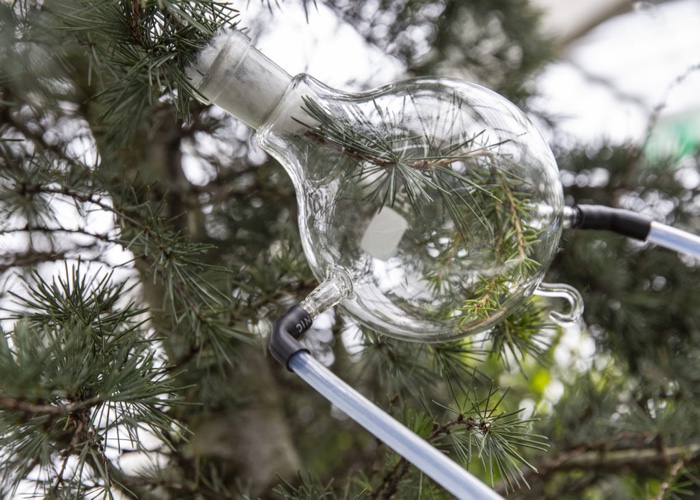
Agnes Meyer-Brandis, How to Become A Tree For Another Tree (measuring chamber). Photo: © 2018 | ITMZ | Universität Rostock
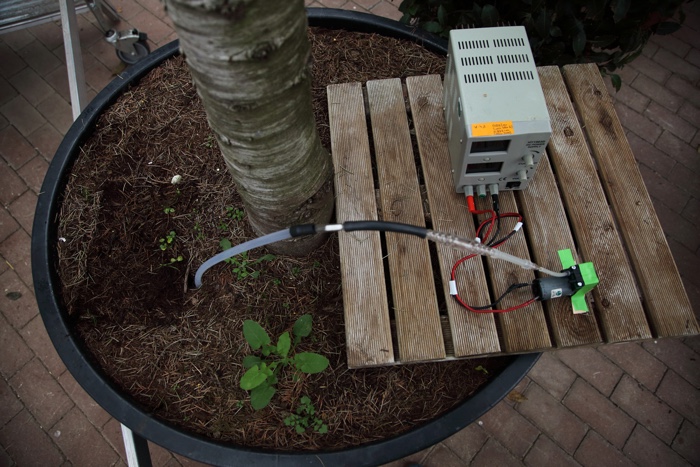
Agnes Meyer-Brandis, How to Become A Tree For Another Tree (Measuring VOC emissions of the roots), Rostock 2018
Can you tell us about the tools you and the scientists used to collect and identify the cloud? there are photos with big glass bubbles! Are they scientific instruments or are they one of your artistic contraptions?
These are the measurement chambers, with the help of these chambers we collect the air / gases and molecule samples which then are analysed by a special gas chromatograph (GCMS) with mass spectrometer.
These chamber measurements are quite common as scientific method, though how a chamber looks like always differs as each chamber is designed by its scientist, so i also designed my tree stem chamber myself, for example.
Could you describe briefly the installation you were showing as part of Experiment Zukunft at Kunsthalle Rostock? Could visitors try out the cloud perfume?
Yes, the installation consisted of an experimental set up with the tree, a Himalayan Cedar, which we were measuring, and its synthesized One Tree ID, as well as the other 3 perfumes “Cloud of the Roots”, “Cloud of the Tree Stem” and “Cloud of the Tree Crone”. The visitors can apply the perfume and then have a talk with the tree, following an experiment routine, with a start and stop, so we could potentially track and measure the dialogue between tree and human.
As the VOC emissions are a dynamic system, there was also a board with One Tree IDs of each exhibition day.
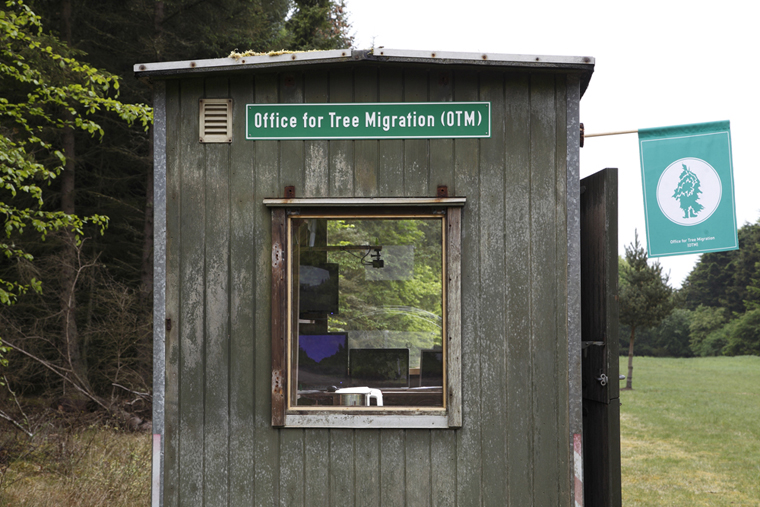
Agnes Meyer-Brandis, Office for Tree Migration (OTM)
Quick question about another of your projects! You explained in an interview with Interaliamag that you were working on “a possible system by using options of synthetic biology that allows the trees to move faster and simply walk away from the changed climate”. This sounds very exciting! Are you still working on this Office for Tree Migration project? Did scientists slam the door at your face and told you you were crazy?
It is a longterm project manifesting itself in various artistic outputs and formats. For example, we have designed small tree molecules to observe tree migration on molecular level, in cooperation with Alex de Vries from the University in Groningen without any door slamming.
So far, I’ve been researching on this topic and possible investigation, adaption and migration methods on the northern hemisphere, but at the moment I am doing research on that topic in California where drought and warmer climate are a problem. So the Office for Tree Migration is temporarily settled at the Marin Headlands, where I do longterm observations of plants climbing up hills.
Actually scientist didn’t slam the door, I had several interesting discussions, as in any field of work there people who are more and less open-minded people. I am apparently lucky with my science encounters. What I heard is both interesting and very open thinking. However, I also heard that to find a solution and create walking trees, we would need to combine all human knowledge for the next 30 years, something that’s obviously not existing yet. Nevertheless, it is do-able.
Anyhow, i am working on finding out, getting all sorts of necessary preliminary experiments defined which may pave the way towards walking trees but we have to start small and hopefully create a tiny walking tree arboretum in the near future.
The exhibition in Rostock is over, but the project had received an honorary mention at Ars Electronica this year and will be shown there as well (hopefully! It is not easy to exhibit as it is not only site- but even tree specific!)
Thanks Agnes!
Project Credits: In collaboration with Prof. Dr. Birgit Piechulla and Dr. Uta Effmert, Biochemistry, Institute for BioSciences, University Rostock and Marc vom Ende, Senior Perfumer, Symrise. With kind support by the Stiftung Kunstfonds, Symrise AG and Universität Rostock.
The works was part of Experiment Zukunft, a show curated by Susanne Jaschko at Kunsthalle Rostock in Germany.
Also part of the exhibition: Semina Aeternitatis: can you inscribe human nostalgia onto foreign DNA?
